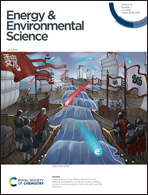A low-charge-overpotential lithium-CO2 cell based on a binary molten salt electrolyte†
Abstract
The high charge overpotential of Li–CO2 batteries leads to short calendar life and low energy efficiency. Solid catalysts such as functional carbon materials and noble metals have been studied extensively to facilitate the decomposition of Li2CO3. However, the charge potential is still over 4 V and side reactions of electrolytes are still unavoidable. Unlike progressively developed catalysts, few efforts have been made for the optimization of electrolytes, which is the bottleneck to develop practical Li–CO2 batteries. Here, we demonstrate a binary molten salt Li–CO2 battery operating at elevated temperature. In the presence of an involatile molten salt electrolyte, CO2 evolution during the charging process can be controlled below 3.6 V with a carbon cathode, which is even lower than previously reported values with noble metal catalysts. In addition to this optimized electrolyte solution, Ru nanoparticles with high catalytic activities are also prepared for the solid cathode. Based on this heterogeneous electrocatalysis, the charge potential of this Li–CO2 battery is further reduced to 3.2 V, and the cycling life is extended to 70 cycles. This work provides a promising strategy to extend the working conditions of Li–CO2 batteries to higher temperatures. It also provides a direct insight into the reduction of the high charge overpotential of Li–CO2 batteries, and mitigation of electrolyte decomposition.



 Please wait while we load your content...
Please wait while we load your content...